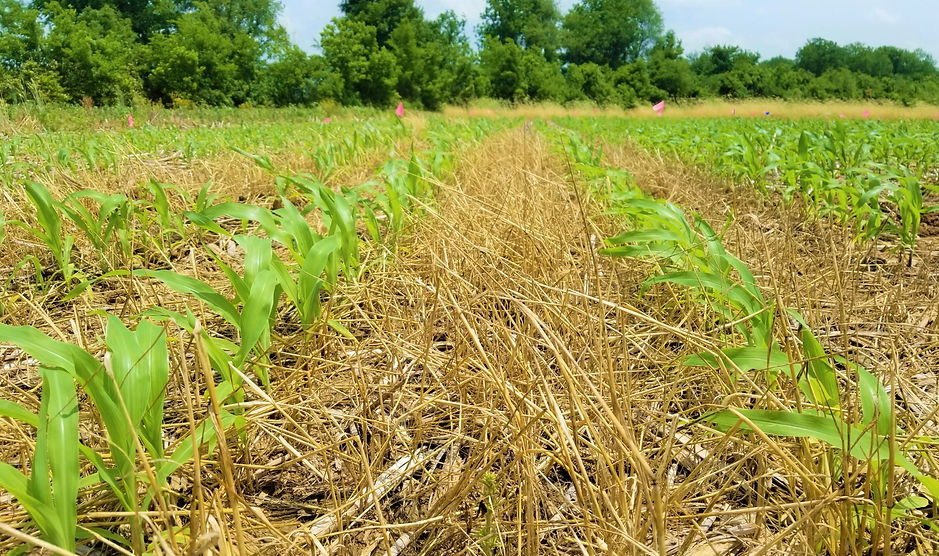
Key Principles
We prioritize regenerative agriculture's six key principles for their transformative potential in Kansas and beyond. By emphasizing crop diversity, reduced tillage, soil cover, living roots, integrated livestock, and context-specific practices, KSURA supports efforts to restore soil health, conserve water, and build resilient farming systems. These principles collectively improve soil structure, enhance water retention, increase biodiversity, and foster carbon sequestration, creating sustainable, profitable agricultural systems that also help mitigate climate change.
6 Principles of Regenerative Agriculture: Cultivating Resilient, Sustainable Farms
Fostering a sustainable future by embracing the principles of regenerative agriculture.
Regenerative agriculture is reshaping how we approach farming, focusing on restoring soil health, promoting biodiversity, and building climate resilience. These six principles serve as foundational guidelines for creating a sustainable, productive, and balanced agricultural ecosystem.

Six guiding principles for regenerative agriculture promote soil health, biodiversity, and sustainability in farming.
Maximize Diversity: Crop Rotations and Microbial Inoculants
Modern farming often relies on monoculture systems, which depend on synthetic inputs for managing soil fertility and controlling pests. However, diversifying crop rotations and using microbial inoculants can improve soil health and financial resilience, reducing the need for chemical inputs. Studies show that simply adding one or more crops to a monoculture system increases soil carbon stocks by an average of 3.6% (Smith et al., 2022). Diversity can also be enhanced by including perennial crops or prairie strips, which help prevent erosion, reduce nutrient leaching, and support native pollinators, creating a more balanced and sustainable system.
Adopt No-Till or Reduced-Till Practices
No-till and reduced-till methods are essential for preventing soil erosion and protecting soil structure. These practices minimize soil disturbance, reduce evaporation, and improve water infiltration, especially valuable in arid regions like the US Great Plains (Brown & Williams, 2023). By protecting soil organic carbon (SOC) stocks and increasing their mean residence time, no-till also contributes to reducing atmospheric CO₂, enhancing soil water availability, and building resilience to climate variability.
Keep the Soil Covered: Mulching and Cover Crops
Maintaining soil cover is key to protecting farmland from erosion, reducing moisture loss, and suppressing weeds. Crop residues and cover crops provide this essential protection, shielding soil from the impact of wind, rain, and sun. Cover crop mixtures, especially those with legumes, often enhance soil organic carbon (SOC) levels (Johnson et al., 2023). This practice also supports environmentally friendly farming by reducing reliance on synthetic herbicides and fertilizers.
Maintain Living Roots: Incorporate Perennial Crops
Perennial plants with deep, extensive roots are central to regenerative agriculture, improving soil structure, fertility, and moisture retention. These living roots foster microbial diversity, increase organic matter, and prevent erosion, while supporting the soil’s resilience to extreme weather events like droughts. Integrating perennials into crop rotations enhances soil health and provides long-term ecological stability (Lee et al., 2021).
Integrate Livestock: Crop-Livestock Systems and Grazing Management
Incorporating livestock into farming systems offers a range of regenerative benefits. When managed effectively, livestock grazing can enhance soil carbon storage and improve soil health. Practices like rotational grazing, where grazing intensity and duration are managed based on climate, water availability, and soil type, can significantly boost soil carbon (Anderson & Miller, 2024). Livestock integration also creates a closed-loop system where manure acts as a natural fertilizer, and biogas from manure can serve as renewable energy.
Understand Context: Tailoring to Specific Agroecosystems
The final principle emphasizes adapting regenerative practices to the unique conditions of each farming environment. Soil type, climate, and specific farm goals guide the implementation of regenerative practices. This adaptability maximizes benefits while supporting social, economic, and environmental sustainability. Although long-term studies are limited, collaborative efforts with farmers continue to demonstrate the value of context-specific regenerative management practices (Thompson et al., 2023).
Regenerative agriculture provides a holistic framework for improving soil health, building climate resilience, and reducing reliance on synthetic inputs. Through principles like maximizing diversity, minimizing tillage, keeping soil covered, maintaining living roots, integrating livestock, and understanding the unique agroecosystem context, regenerative practices support productive and sustainable farms. By adopting these strategies, farmers can create resilient systems that benefit both the land and future generations, paving the way for a sustainable agricultural future.
1. Smith, J., et al. (2022). Impacts of Crop Diversity on Soil Carbon Sequestration. Journal of Sustainable Agriculture.
2. Brown, T., & Williams, A. (2023). Tillage Practices and Soil Carbon Storage in the US Great Plains. Soil and Climate Research.
3. Johnson, K., et al. (2023). Benefits of Legume-Based Cover Crops on Soil Health. Agronomy Journal.
4. Lee, P., et al. (2021). Role of Perennials in Soil Health and Climate Resilience. Ecological Farming Systems.
5. Anderson, L., & Miller, R. (2024). Integrating Livestock in Crop Systems for Regenerative Farming. Journal of Agricultural Management.
6. Thompson, D., et al. (2023). Context-Specific Regenerative Agriculture Practices. Journal of Agroecology.
